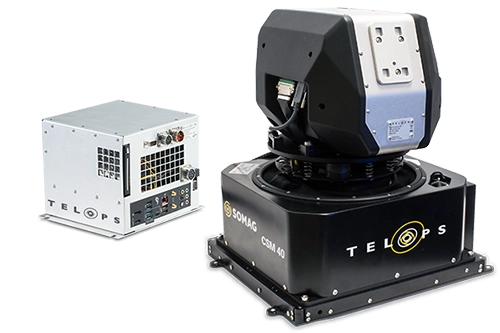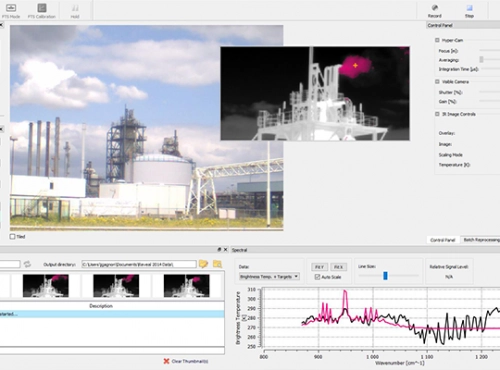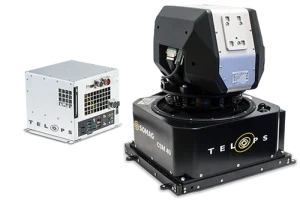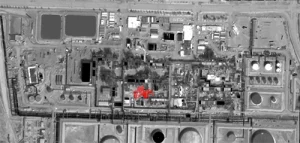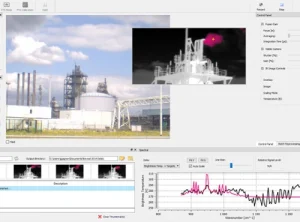Overview
The Hyper-Cam Airborne Mini, a pivotal innovation from Telops, ushers in a new era of compact airborne hyperspectral imaging systems. This state-of-the-art lightweight FTIR sensor is a beacon of innovation in the field of infrared hyperspectral imaging. Designed to operate seamlessly within compact aerial platforms, the Hyper-Cam Airborne Mini exemplifies the fusion of high-fidelity measurement performance with the practicality of a small footprint. This combination of features positions the Hyper-Cam Airborne Mini as an essential tool in a variety of critical applications, ranging from ground target signature collection and mineral mapping to gas detection and identification.
This groundbreaking system has been meticulously engineered to provide unparalleled performance without the bulk and complexity traditionally associated with advanced hyperspectral imaging systems. Its compact size, weighing only 24 kg and occupying less than 2 cubic feet, belies its powerful capabilities. This attribute makes the Hyper-Cam Airborne Mini not just convenient for deployment, but also a game-changer in terms of expanding the possibilities of aerial hyperspectral imaging.
The Hyper-Cam Airborne Mini offers unmatched spectral resolution, user-selectable up to 0.5 cm-1. This high level of spectral detail, combined with swappable fore-optics, allows for precise and adaptable ground coverage, ensuring that the system can be tailored to the specific requirements of a wide array of applications. The high spatial resolution provided by the latest 320 × 256-pixel cooled SLS detector guarantees excellent 2D image quality, crucial for accurate analysis and interpretation in diverse scenarios.
Moreover, the system’s capability to record hyperspectral data over time adds a dynamic dimension to its operation, enabling the characterization of time-dependent events such as gas cloud dispersion and combustion. This high temporal resolution, adaptable based on acquisition parameters, allows for the fastest recording of dynamic events, making the Hyper-Cam Airborne Mini a formidable tool for capturing and analyzing rapid environmental changes.
Another hallmark of the Hyper-Cam Airborne Mini is its extreme flexibility. The system comes with a separate optical head and processing unit, accompanied by powerful software that provides comprehensive control and data processing. This modular approach not only enhances the system’s adaptability to different operational scenarios but also empowers users with complete control over their hyperspectral imaging tasks.
In essence, the Hyper-Cam Airborne Mini by Telops is more than just a hyperspectral imaging system; it is a symbol of technological advancement, bringing together compactness, flexibility, and high performance in a package that is well-suited to meet the demands of the most challenging applications in the modern world of remote sensing and aerial imaging.
Highlights
Compact & Lightweight
- Ease of Installation and Transport: The system’s design, with a total weight of only 24 kg and a volume of less than 2 cubic feet, facilitates easy installation and transport, making it highly suitable for various compact aerial platforms.
- Versatility in Deployment: Its lightweight nature enables deployment on a wide range of aerial vehicles, including UAVs and small aircraft, expanding the scope of potential applications.
Selectable Spectral Resolution
- Optimal Spectral Analysis: Offers the highest spectral resolution available in its class, user-selectable up to 0.5 cm-1. This feature allows for precise spectral analysis, critical in identifying and differentiating materials or gases.
- Adaptable to Various Scenarios: Swappable fore-optics enhance the system’s adaptability, ensuring optimal ground coverage for different scenarios and objectives.
High Spatial Resolution
- Unrivaled Image Clarity: The system boasts the highest spatial resolution on the market, using a state-of-the-art 320 × 256-pixel cooled SLS detector, which translates to exceptional 2D image quality.
- Detailed Ground Coverage: Its high spatial resolution enables detailed coverage of ground targets, essential for accurate mineral mapping, ground target signature collection, and other remote sensing applications.
High Temporal Resolution
- Dynamic Event Characterization: Capable of capturing hyperspectral data as a function of time, which is pivotal in analyzing and understanding dynamic, time-dependent events such as gas cloud movements or combustion processes.
- Rapid Data Acquisition: The system’s design allows for the fastest recording of dynamic events, with measurement times varying based on acquisition parameters. This flexibility is crucial in capturing rapid temporal changes.
Extreme Flexibility
- Modular Design for Versatile Use: Comes equipped with a separate optical head and processing unit, offering extreme flexibility in various operational environments and scenarios.
- Advanced Software Suite: Includes powerful software for comprehensive control and data processing, enhancing the user experience and providing robust support for complex hyperspectral imaging tasks.
Technical Specifications
- Spectral Range: 7.4 – 11.8 µm, covering a broad range of applications.
- Pixel Field of View: 750 µrad, enabling detailed imaging.
- Total Angular Range: 13.5 x 10.9°, providing wide area coverage.
- Optical Head Inclusions: Features image motion compensation mirror, boresighted visible camera, and GPS/INS+ platform.
- Power Consumption: Less than 260 W, ensuring energy efficiency.
- Head & Platform Size: 28 x 35 x 38 cm, compact for easy integration.
- Control Box Size: 23 x 21 x 18 cm, small yet functional.
- Head & Platform Weight: Less than 20 kg, lightweight for airborne applications.
- Control Box Weight: Less than 4 kg, adding minimal load.
- Typical NESR: Less than 35 nW/(cm-2 sr cm-1), ensuring high sensitivity.
